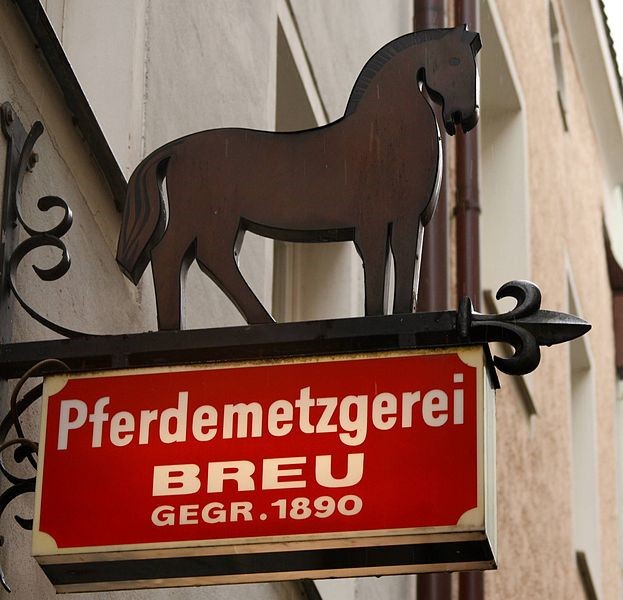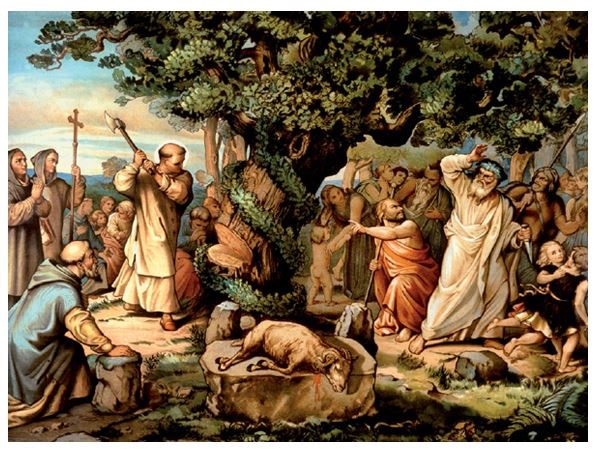Having Friends for Dinner

The fraught history of Germans eating horses
Volker Bach continues his occasional series on German historical recipes.
Culinary history has not enjoyed great regard in German academia. Scholars long viewed it as trivial, and errors abound even in relatively recent publications. There is one point, though, that every medieval historian in the country is aware of: the church banned the eating of horsemeat.
The fact is memorable, its impact continues to be felt, and the evidence is clear: around the year 732 AD, Pope Gregory III writes to (soon to be Saint) Boniface on the occasion of his elevation to missionary bishop for Germany, informing him:
Among other things you report that some eat wild horses and more domestic ones. Under no circumstances must you ever allow this to happen, most holy brother. Intercede, with the help of Christ, whenever you can and assign the deserved penance; for it is unclean (inmundum) and execrable (exsecrabilis).
(Bonifatii epistula 28)

St Boniface in full missionary mode. The felling of the sacred oak of Fritzlar is probably ahistorical, but remains the most famous episode in his life. Nineteenth-century depiction, source: Wikimedia)
This has attracted much speculation. The prohibition was later restated by Pope Zachary III and never officially rescinded, though a temporary exception was made for the newly converts of Iceland1. From a theological perspective, it is decidedly odd: it is the only food prohibition in Western Christianity, and scripturally, it has no leg to stand on. Early Christianity was proud of having no dietary taboos.
German scholars have suggested that the ban was meant to keep Christians away from pagan horse sacrifices at burials, but no source links the ban on eating sacrificial meat to horses. A materialist interpretation championed by Marvin Harris2 argues it is rooted in the conversion of the Carolingian Empire’s army to a cavalry force which needed horses to be ridden rather than eaten, but recent scholarship casts doubt on whether this actually happened at all3. Finally, it is also possible that it is just an expression of the Greco-Roman revulsion at eating horses4. Outside of cultic contexts, Romans almost never ate horse if they could help it. Ancient Germans seem to have relished it.
The Middle Ages embraced the idea that eating horse was a bad pagan habit. In the 12th-century Song of Roland, pagan realms are described:
The land is accursed / the sun never shone there / fog lies upon it / grain is scarce / the rocks are black / there is wood and moss / they eat horses / they live savagely / the devil dwells there5
As late as 1817, a popular history book referred to the pre-conquest Prussians as “…savage peoples without estates…” caught in “…deepest, darkest paganism…” who “…lived on horseflesh and fermented mares’ milk.”6
Interestingly, the medieval prohibition was softened by introducing the distinction between domesticated horses, which were eaten only in the direst of emergencies, and wild ones, which qualified as game and were occasionally served at noble tables. References to this are rare, though. The only recipe is found in the encyclopaedic 1581 cookbook by Marx Rumpolt:
(Meat) of a wild horse may be served in a black pepper sauce. If you wish to roast it, salt it well, for it is a sweet meat. You can also season the roast with garlic. If you would cook it in a pepper sauce, set it on the fire with water well salted. When it is cooked, draw it out on a board and let it cool. Make a good slightly sour Hungarian pepper sauce with chickens’ blood and when it is ready, place the meat in it, that is good and lovely. You may also prepare the bollocks (die Geil) as of a domesticated horse, as is described above for goats’ bollocks.7
Testicles of domesticated horses would have been available as colts were castrated, but it is difficult to imagine that this dish was ever widely popular.
Most references to eating horsemeat relate to poverty, war, or famine. It was something one was reduced to doing, and the image of a dead horse turned into food remains a staple of the oral history of both World Wars. Even after Napoleon’s reordering of Europe imposed a liberal, modern law code on the patchwork of German states that ended enforcement of the church prohibition, the stigma remained. No equivalent of Emile Decroix rose to popularise hippophagy – horse remained something Germans generally would not choose to eat.
There were always those who had no choice, though. When the Prussian state first required cities to provide municipal abattoirs to control the abuses of a deregulated butchering trade in 1868, provisions were made to process horses. They were to be kept strictly separate from other animals at all times. Horse butchers needed written permission to even enter the rooms where pigs or cows were slaughtered.8 Horsemeat, tainted with the stench of poverty, could not be allowed to contaminate proper food.
This principle of separate and unequal lasted: until 1993, horsemeat could not legally be processed or sold together with any other meat, and the tradition is tenacious. Low demand, difficult supply9, and the high cost of maintaining dedicated premises mean that many Rossschlachtereien nowadays sell through market stalls rather than shops. They are often family businesses sourcing their meat locally and maintaining a craft tradition. Regular butchers and supermarkets rarely sell horsemeat.
It is interesting that the only local specialty of any gourmet standing that involves horsemeat comes not from the staunchly Calvinist Prussian east or the famously adventurous maritime cities, but from the deeply Catholic Rhineland10: Rheinischer Sauerbraten, a vinegar-marinated roast in a sauce sweetened with raisins, gingerbread, or dark beet sugar syrup. However, when it is offered to tourists, local hostelries mostly opt to use beef these days.
Footnotes
1. Ari Islendingabok 7, translation online here
2. Marvin Harris Good to Eat. Riddles of Food and Culture Illinois: Waveland Press 1998
3. The controversy is outlined in Bernard S. Bachrach Early Carolingian Warfare: Prelude to Empire Philadelphia: University of Pennsylvania Press 2001
4. The Greek church already had horsemeat bans on the books as early as the fourth century, though this issue was rarely contentious and never took on the cultural importance it did in the Latin West. See: Ulrike Gudehus Die Entwicklung der Pferdeschlachtung und des Pferdefleischkonsums in Deutschland unter Berücksichtigung der gesetzlichen Änderungen Munich: doctoral dissertation 2006, p. 5
5. This is not a description of any real pagan country, though its array of stereotypical scenes may be based on accounts from missionaries to Scandinavia. It certainly bears no resemblance to either Basque country or the Muslim states of the Iberian peninsula, the origins of Roland’s historical foes, and there is no reason to think horse was eaten there. Translated from Dieter Kartschoke (ed. and trsl.) Das Rolandslied des Pfaffen Konrad Stuttgart: Reclam 1993, 2684-2692. An earlier edition of the text is online here
6. The reference neatly combines the stereotypes of medieval sources with the prejudice of the nineteenth century which viewed horse nomads as the ultimate form of barbarism. Benedikt Andreas Durst Teutschlands Geschichte Nuremberg: Riegel & Wießner 1817, vol. I p. 502. Online here.
7. This is not much for a cookbook that devotes several pages to chamois and a whole chapter to wild boar. Roughly equal space is given to marmot and guinea pig (a topic for a future post). Clearly, wild horse was an exotic taste, though the reference to its sweet flavour suggests experience underlying the recipe. See: Marx Rumpolt Ein New Kochbuch… Frankfurt (Main): Sigmund Feyerabendt 1581, LVI r.
The recipe for goats’ testicles is on p XXV v.: To cook bollocks of ram or goat: Take them and throw them into the fire so the tough skin breaks open straightaway, then take them back out, place them in cold water and clean them. Pull off the tough skin, set them by the fire in water and boil them well so that the smell and the gall (bitterness) is drawn out. Make a tasty pepper sauce with chickens‘ blood, beef broth, sour it with vinegar, add bread and apples, let it boil together, and when it has cooked, pass it through a cloth so it is smooth and season it with gentle spices, with cloves, cinnamon, pepper and saffron. Boil it again, then add the bollocks and boil them along with it. But if you would have fried onions (geschweißte Zwibeln) added to it, take onions, cut them up small, then chop them so they become smaller, fry them in butter or pig lard and when they are fried, season them with spices as described above and let them boil in the pepper sauce. This way, the onions are lost (dissolved) in the pepper sauce and it turns out tasty. For it is a great feat to cook pepper sauce properly, especially for banquets where you must serve pepper sauce for ten or twelve tables you must pay attention that it does not burn.
8. H. Heiss Bau, Einrichtung und Betrieb öffentlicher Schlacht- und Viehhöfe, fifth edition, Berlin: Julius Springer 1932 says on the subject: “The meat of horses, if it comes from healthy, well-fed animals, is a fully valid meat that, if cooked properly, is not recognised as horse even by gourmets. It is, however, out of the question for horses to be slaughtered in the general abattoirs. If very small numbers of horses are slaughtered, this can be done in the places reserved for sick livestock. … for small abattoirs, a separate space for slaughter is enough, but in facilities that process 200-300 horses a year, additional winches are needed to prevent the carcasses being hung warm. A single winch will be enough if a rail is built to move the slaughtered horses.” (p. 133)
“Horses, donkeys, mules and dogs may only be slaughtered in the horse abattoir separated from the regular abattoir. The horse abattoir may only be entered by the horse butchers and their staff. Horse butchers need written permission from the management to enter the other parts of the abattoir, as do regular butchers to enter the horse abattoir. Only horses for slaughter may be kept in the stalls. …” (p. 554). Online here
9. With horses no longer used widely as draft animals, it is increasingly difficult to find animals for sale. Most horses are now sporting or companion animals and even if their owners are willing to sell them, drugs administered by veterinaries can make them illegal to process for human consumption. This was one of the health concerns raised by authorities in the infamous 2013 horsemeat scandal.
10. In Catholic Bavaria horsemeat butchers can be found to this day, especially in Munich’s Vikualienmarkt.
